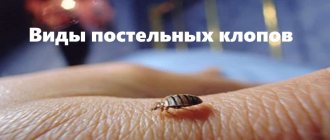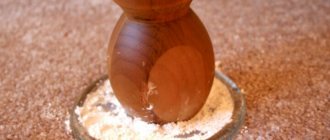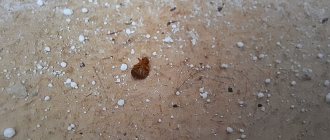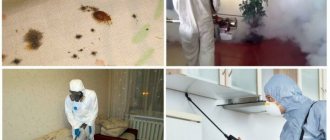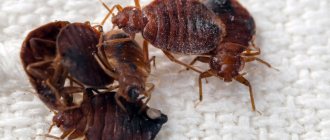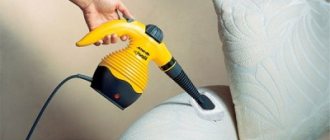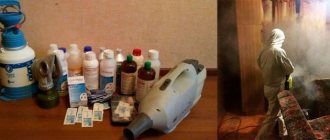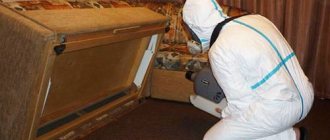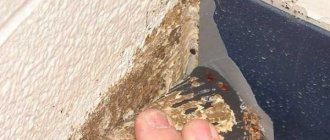- By Vil Malinoshevsky
- About bedbugs
To remove bedbugs from your apartment or house once and for all, you need to know how they are transmitted and how they get there. Our subscribers constantly complain that they have already poisoned bedbugs and they disappeared for a month or two, and then appeared again. At night, the parasites began to bite them again, and they, in turn, went to buy new aerosols and re-spray their homes with them. The next disinfestation also turned out to be effective, but, as a rule, not for long. After a while, everything started all over again.
This is due to the fact that bedbugs easily move from apartment to apartment through different crevices. Also, sometimes the residents themselves carry them on their clothes. As a result, people poison them and destroy them, but soon new ones appear in their place. Thus, disinsection must be repeated regularly. However, if you can find out how bedbugs get into the house and seal their passages, then you will be able to get rid of the parasites for good.
To some extent, knowing exactly how bedbugs enter an apartment is more important than knowing how to destroy them. Professional exterminators can do the latter for you, but only you can protect your home from re-infestation. In addition, there are even special traps that allow you not to poison bedbugs, but simply catch them all. However, they are only effective when the main nests of parasites and the ways of their penetration into the apartment are found.
How do bedbugs get to high points?
If any insect wants to climb to heights, it needs the right tools.
To get up, you need to grab onto something. Animals use their feet, hooves or claws to propel themselves upward. Bed bugs have hook-like feet at the end of their legs, which they use to grasp micro-ledges in their path. As they move step by step, these tiny hooks find a gap in the surface to hold them. For them, these are real handrails that are found on climbing walls.
Please note that their “claws” are not thin enough to grab hair, but they help them climb wood and plaster coverings that have many microscopic cracks, lumps, and irregularities. It is on them that the linen bug finds its support
This class of beetles is not deprived of the talent to quickly climb up. It is believed that the tropical bug is the best climber, but why this happened is still unclear.
These house insects can crawl around your bedroom or apartment almost anywhere. What are the objectives of this tourism?:
- They crawl to find new cover, in bedding or furniture
- Linen bugs crawl to find their way to you at night so they can feed on your blood.
- Annoying insects crawl to avoid a threat when they want to be kicked out
- They prefer to move on flat surfaces, but can climb inclines or even vertically. They identify you and build their route through the search for warmth, human pheromones and carbon dioxide. Then they crawl there? They can sense you within a few meters.
Of course, they crawl slowly compared to other pests in the house; even street bugs are faster than them. They are not fast enough to escape from you unless there is other cover nearby.
Instead of relying on speed, bed bugs have the ability to hide. They will choose a hiding place that is difficult for any threat to enter. Therefore, their life schedule is as follows: a foray to a food source, and then they quickly return to their secluded corner to digest.
How else do bed bugs get on beds?
House bugs are not flying creatures. They make their way to mattresses by crawling along the legs of bed frames and nearby objects that touch the bed.
Sheets, bedspreads and other bedding that hang low enough to touch the floor can also serve as a means of access. When the headboard or other parts of the bed touch the wall, bed bugs can move onto the bed.
How fast can bed bugs move?
These annoying pests can crawl at speeds of one meter per minute on most surfaces.
This may not seem fast, but when scaled to human standards, the speed is equal to the running speed of an average adult. This is comparable to many species of ants, which are certainly fast enough to find a crack or crevice to hide in a bed or bed frame.
What should I do if I see a bedbug?
If you see or suspect that nasty creatures are crawling on a mattress or anywhere else, try to catch them, destroy them yourself using a variety of chemicals, vacuum them, freeze them, or kill them by treating things for a long time with something hot, but it’s easier and calmer for nerves, contact sanitation specialists for help.
What clothes can bedbugs be found on?
Insects can hide on any surface - smooth or textured. But they do not move well on fur or materials with long pile. They can be found on natural and synthetic fabrics - the composition of the material does not matter at all.
If a closet with clothes is infested with bedbugs, they can be seen everywhere - on underwear, pajamas, light shirts or blouses, and outerwear. Bed bugs prefer dark and secluded places, so they try not to stay on the surface, but climb inside: into pockets, into seams, behind lapels. They do not know how to gnaw through fabric, so they hide where they can crawl outside.
The bugs themselves do not spoil clothes, they do not gnaw them, and do not leave marks or snags with their paws. But if you crush a bedbug on fabric, a red or brown bloody stain may remain if the pest has not yet had time to digest the food. There may also be spots from excrement.
Females lay eggs, as if gluing them to the surface with a sticky secretion. Thanks to this, eggs can be located anywhere, including on inclined or vertical surfaces. It’s not always easy to just brush them off; sometimes you have to use a hard brush to do this.
How to deal with flying and non-flying bedbugs
The development of wings in insects depends on their lifestyle. If a bug feeds on the foliage of plants and trees, it needs to fly long distances. Wings are not needed near the victim. Depending on whether the pests are flying or crawling, you can choose an effective method of control. For those flying, you will need traps and special repellers. Crawling specimens hide and are more difficult to catch using these methods. To catch, use other means of disinfestation.
There is a fierce fight against pests of farmland, berry fields and domestic representatives. In case of mass destruction, they resort to the help of special services. At home, they use improvised means: sticky traps, tapes, sweet fertilizers, homemade traps from plastic bottles.
Single flying bugs do not pose a threat; there is no point in fighting them. If a flying squirrel is found in an apartment, it is better to catch it with a matchbox and release it outside.
To prevent an uninvited guest from disturbing you again, install mosquito nets on the windows, place rags soaked in vinegar on the window sills, and seal the window and balcony cracks on the street side with sealant. If the bedbugs have not disappeared, resort to insecticides.
How parasites run and spread
Bed bugs, for all their slowness, are able to travel vast distances, spreading both throughout the infested apartment and neighboring rooms. During the night, bloodsuckers can cover a distance of several hundred meters; they move along external walls, under floors, and through ventilation shafts. This allows pests to spread through dozens of apartments in one building in a few days.
The speed of movement of bloodsuckers is several times lower than that of ordinary cockroaches. If you find an insect in your living space that is difficult to squash, you can say that it is not a bug, but a red cockroach larva. These pests have comparable body shape and size
Objectively speaking, among all the varieties of bedbugs, fast-running individuals can be counted on the fingers of one hand. The shield subspecies travels long distances using krill, as they crawl very slowly. As for “predatory” bugs, they attack mainly mollusks, larvae and caterpillars, which are also inactive.
Symptoms of bed bug bites
The symptoms are individual for everyone: some do not notice them until they see red dots on the body, while others begin to experience severe discomfort due to itching. Unlike a mosquito bite, the mark of a bug remains longer and is distinguished by bright redness with characteristic compaction and swelling.
You can only feel the moment of the bite if the larva is biting, because it has already developed an anesthetic secretion.
If the skin is very swollen and the redness has spread far beyond the damage, then you are allergic to bedbug bites. The following symptoms may appear:
- general weakness in the body;
- nausea, vomiting;
- dizziness;
- muscle spasms;
- lack of air.
If you have these symptoms, take an antihistamine immediately and consult a doctor.
If there are no allergies or complications, it will be enough to disinfect the damage with alcohol or soda solution and apply Fenistil or other gel with a healing and soothing effect.
Furniture bugs
Insects found not in the bed, but in other furniture, are representatives of the species bed bugs. With a multiple increase in the number of parasites, they begin to spread throughout the room and move into neighboring rooms. They hide in the drawers of bedside tables and chests of drawers, on the shelves of closets, behind paintings and mirrors.
Bedbugs are found in furniture only during the day; when night falls, they move to the nearest place where a person sleeps.
How to get rid of furniture bugs?
There are many methods for exterminating pests:
- thermal;
- chemical;
- folk recipes.
Treating furniture at home with chemicals is considered the most effective method. The “Get” insecticide, produced in the form of a suspension, has proven itself well. It is diluted with water and sprayed on all surfaces. The product retains its effect on parasites for several months. Aerosols “Combat” and “Clean House” are popular. They paralyze insects and quickly cause death. The downside of the drugs is toxicity and a pungent odor.
As a heat treatment, furniture is subjected to freezing or exposure to steam. Folk recipes recommend the use of essential oils (lavender, tea tree) and herbs (wormwood, tansy). It is often suggested to treat furniture with vinegar or other products with a strong odor. Such recipes only have a deterrent effect. If you can’t deal with parasites on your own, call a professional.
Interesting Facts
Residents of apartment buildings should know some signs of the presence of linen bloodsuckers indoors:
- The bug has an odor reminiscent of coriander.
- An indisputable sign of the presence of insects is complaints from family members about the appearance of numerous bites located on the body.
- Peak food intake for parasites is from 0:00 to 05:00 hours.
- An insect that feeds on blood can go without food for 2 months.
- An adult quickly finds a food source, because senses the warmth of the human body and the presence of carbon dioxide in the exhaled air.
- A bug bite causes an allergic reaction in 80% of people.
- The insect is often the cause of anemia in young children.
- Triatomidae are carriers of the causative agent of Chagas disease or American trypanosomiasis.
- An increase in the number of blood-sucking parasites is facilitated by the formation of populations resistant to the effects of insecticides, for example, 25% of cypermethrin, which is part of disinfectants.
There are many ways to combat home bugs, which allow you to destroy all blood-sucking insects living in the room.
Drugs and preventive measures
Regular washing of bedding and ironing helps to effectively cope with parasites. But not all fabrics can be washed at high temperatures and ironed. To neutralize allergens and cope with mites at any temperature, a special Acaril liquid is added to the washing machine. The same product, released in powder form, can be used to clean carpets.
Wet cleaning is the main weapon in the fight against dust and its inhabitants. Its effect can be enhanced by adding special All-Rug shampoo to the water. The product is sold as a concentrate and can be used to clean natural and synthetic pile of furniture and carpets. It is used in a washing vacuum cleaner and for manual cleaning. The drug is diluted 1:30 in the first month, then a solution of 1:60 is sufficient. The product removes dirt, allergens and mold well, and has a pleasant aroma.
Allergoff spray is capable of destroying parasites at any stage of development. The aerosol form makes it easy to treat mattresses, blankets, carpets and upholstered furniture. The action of the acaricidal drug causes the death of mites in down pillows 1 hour after spraying. Bedding must be treated from all sides.
Spray "Akarosan" when sprayed, penetrates into the body of dust mites when feeding and through the chitinous shell. The main active ingredient of the drug is benzyl benzoate. The spray enlarges arthropod excrement, allowing it to be collected with a vacuum cleaner. Particles of the drug remain in the structure of the treated surface for a long time. They have a detrimental effect on subsequent generations of ticks. The protective effect of Akarosan is 6-9 months.
Folk recipe
There are specially developed formulations that help fight feather mites. Sanitation services treat premises with solutions that are safe for people, but have a negative effect on insects. But you can also purchase anti-tick chemicals yourself, diluting them strictly according to the instructions. Effective drugs include:
- Tsifekos powder, which is diluted in water, eliminates feather mites for one month.
- Emulsion Sipaz means for disinfection in residential premises. Fights insects for 30 – 45 days.
- Based on medicinal herbs, there are sprays for treating bed linen that eliminate feather mites in three hours.
- Easy Air product, developed based on natural ingredients.
- Allerqoff spray for treating mattresses, carpets, and upholstered furniture helps reduce the number of mites.
We suggest you read: Can lice jump?
We don’t end our search on the bed...
In our practice, we were sometimes able to find bedbugs in completely unexpected places. I’m not talking about baseboards and under parquet floors - they are almost always there. But it happens that their nests are found behind books on shelves and behind the shelves themselves, inside laptops and computer system units, behind pictures on the walls, in safes, in sockets, in old things that people have not worn for a long time.
Simply put, the bed is just the beginning. This is where you discover bedbugs and this is where you start looking for them. And where you will find all the other nests is very difficult to say. The main thing is to understand that bedbugs are not only infested in beds. It’s very, very rare that this happens: they are in the bed, but not anywhere else.
Now. You found bedbugs in the bed. This means that you need to look for them in the entire room, and preferably in the entire apartment. Here you need to inspect all the cracks, holes, cavities where they can physically get into. The following rule works here: the more difficult it is for you to get to a particular bedbug shelter, the more likely they are to have a nest there.
In our practice, we were sometimes able to find bedbugs in completely unexpected places. I’m not talking about baseboards and under parquet floors - they are almost always there. But it happens that their nests are found behind books on shelves and behind the shelves themselves, inside laptops and computer system units, behind pictures on the walls, in safes, in sockets, in old things that people have not worn for a long time.
It is not possible to get rid of ticks completely and forever; the main rule is to keep the house clean and carefully care for bedding.
What will help get rid of dust microorganisms in pillows:
- Ideally, replace down and feather products with accessories with synthetic filling: padding polyester, holofiber, comforter, which must be washed once every six months at temperatures above 50 °C.
- If you don’t want to part with natural materials, or for children, you can choose an alternative with the following fillings: buckwheat husk, bamboo or coconut fiber, latex.
Fans of fluff and feathers can bring out “guests” in several ways:
- Airing the pillows in the air for at least 5–6 hours gives a temporary effect. In winter - in frost, in summer - in direct sunlight. This method does not work for long, since tick eggs are insensitive to heat and cold, only adult individuals die.
- Once a year it is worth disinfecting such products with special dry cleaning products.
- You can also clean the pillow yourself. The bedstead needs to be washed, ironed (or replaced). Down filling - treat with a soap solution (100 g of laundry soap, 100 g of ammonia per 10 liters of water), rinse thoroughly and dry, then put the product back together.
It is worth noting that it is impossible to get rid of dust mites by cleaning only the bed linen. Additionally, you need to weaken the provoking factor:
- sort out deposits of soft toys;
- reduce the number of carpets and curtains;
- Follow the rules for storing winter clothes.
Also, during wet cleaning, you can add special antiparasitic agents.
Myths about house bugs
Myth one. You cannot see house bugs. The reality is that you are unlikely to be able to see the eggs that bedbugs lay, since they are really very small, but it is quite possible for a person with good eyesight to see an adult bedbug or a nymph bedbug.
Myth two. Bedbugs only grow in places and rooms with unsanitary conditions. In reality, bedbugs do not like dirt and dust at all. The preferred habitat for bedbugs are places that are rich in heat, blood and carbon dioxide. But, nevertheless, dirt and clutter mean that bedbugs can actually be difficult to detect in such conditions.
Myth three. Bedbugs will not attack you in a brightly lit room. In reality, bedbugs, of course, do not like light, but hunger, as you know, is not a problem, and if the bedbugs are hungry, no light will save you from numerous bites.
Myth four. Bed bugs can be easily eliminated using chemicals. In reality, the fight against bedbugs includes a large set of measures and a specific strategy, depending on the situation, and exposure to chemicals is only one step towards achieving the goal of getting rid of bedbugs.
Myth fifth. House bugs can fly, so they can easily enter your apartment through an open window. In fact, house bugs cannot fly, and this is due, first of all, to the fact that bedbugs simply do not have wings.
Myth six. Bedbugs, like fleas, can jump high and are able to jump, say, from the floor onto the sofa. In reality, bedbugs do not know how to jump that high at all, but most often end up on the sofa by falling from the ceiling, and for this they do not need to be able to jump high at all.
So, we hope that in this article we were able to debunk at least some of the myths about bedbugs that scared you. However, do not forget that the fight against bedbugs is a rather labor-intensive process, and if you encounter them for the first time, we still recommend that you purchase special anti-bedbug products or seek the help of professionals and call a pest control team to your home .
Where to look for parasites
- Bedbugs in the mattress. Detecting parasites here is problematic, since most often they settle on the seams or folds of the mattress, or even deep into its filling. After freeing the mattress from the bedding, carefully examine the surface to see if there are any yellow spots on it. If there are no external signs, and the mattress is the only unexplored place, it is better to open it and examine it from the inside. It is advisable to simply get rid of a very old mattress.
- Bed bugs in pillows. This phenomenon is relatively rare. A pillow is exposed to stress more often than other bedding items; a person can turn it over many times during the night, and bedbugs need rest to hide. Unevenly distributed pillow fillings, be it down, feathers or synthetics, are also inconvenient for this insect: it is difficult for them to cling to with their paws and, as a result, to move. However, if there is a suspicion that parasites have settled in the pillow, examine all possible seams, folds of the product, and slots for locks.
- Bedbugs in new furniture. The appearance of parasites in new household items indicates that the insects migrated either from clothing (yours or a guest’s), or from old furniture, or from the fur of a pet. As in all cases of the appearance of these insects, here you have to explore more than one place. Explore the most hidden corners of the furniture. For example, if it's a sofa, check the arms, back, seat, interior drawers, and any dark joints where bed bugs are most likely to live.
- Bedbugs in the car. The reasons for the appearance of these insects in the car are still the same: the transfer of pests in clothes, bags, and any transported items. This problem is most common in taxi cars. People who have “sheltered” parasites at home can take them with them to any other places, especially to places where there is upholstered furniture. Remove unnecessary items and carefully inspect the seats, mats, and luggage compartment of the car. Examine all the items that have been in the salon.
- Bedbugs in clothes. This phenomenon is fraught with the massive spread of parasites. It is not surprising that people who have personally encountered parasites are always concerned about the question of whether bedbugs can live in clothes. Clothing is not the best shelter for these insects, but it is quite suitable for their temporary shelter. Bedbugs can get into clothes from closets, as well as from beds and sofas, if it is nightwear. Eliminate fur items from suspicion; they are extremely inconvenient for bedbugs to hide in. Even for a temporary stop, these parasites need reliable shelter, so you should look in the most inaccessible parts of the product (seams, locks, linings).
Knowing how to locate bedbugs can help you choose the best method of dealing with them. There are many services that specialize in finding and eliminating unwanted insects.
What a bedbug looks like, description with photo
The appearance of a bedbug is characterized primarily by a flattened body, which helps it get between fabric folds without the risk of being crushed by a person. The length of the bug is from 3 to 8.5 mm, depending on gender and blood saturation; females are larger in size than males. Body color ranges from dark brown to dirty beige and even rusty.
In addition to the proboscis for piercing the skin, the bug has sharp bristles for secreting anesthetic saliva into the bite site.
Photo of a bug under a microscope. A proboscis emerges from the front of the head to pump out blood.
Bedbugs are most active at night, especially when they are hungry. A well-fed bedbug increases in size, becomes less agile and more vulnerable; it is the well-fed, crushed bedbugs that leave blood marks on the pillowcase.
Traces of blood may remain on the pillowcase if you crush a well-fed bug in a dream.
Symptoms of infection
The most obvious evidence that there are bed bugs in the house is the discovery of an adult bed bug. At the same time, sometimes a living insect may indicate that the neighbors are being disinfested, and the surviving bloodsuckers have found a new home. Thus, when an adult is identified, the potential habitats of these parasites should be immediately inspected.
Bites on the body
The main symptom of bedbug infestation is bites that regularly appear on the skin. Red marks appear on the neck, back, cheeks and arms. Parasites do not bite in hairy areas; they choose places where the skin is thin and smooth. For this reason, children and women suffer more from these insects.
In this case, the bedbug bites are close to each other, forming a path. The number of red bumps on the skin increases every day along with the insect population, which is rapidly increasing. If the fight against parasites is not carried out, then a person can be bitten up to 300-350 times during the night.
Traces of blood on the bed
The substance that the parasite injects under the victim’s skin disrupts blood clotting. For this reason, a drop of blood appears at the site of the lesion, which, falling on the bed, leaves a mark. Bedding and waste products contaminate.
To remove stains, rinse the fabric in cold water. You can also remove traces with hydrogen peroxide (3-5%).
Hydrogen peroxide removes traces of blood stains after a bug bite.
The appearance of blackheads
Bedbugs are living creatures, so they have a digestive process and waste. Parasite feces are liquid and dark brown in color, but they quickly cool and become hard.
You can find excrement anywhere in your home. Most often, parasites accumulate near or on the bed. The smell of bedbug waste resembles bad cognac.
When the larva hatches from the egg, it molts several times as it grows. Each time it sheds its chitinous coating, which can be found on the floor, furniture, and windowsill.
Unpleasant smell
The sense of smell is a way for bedbugs to navigate in space, mate and notify their relatives of danger.
The aroma that these parasites exude is pleasant - sickly sweet, reminiscent of the smell of almonds or rotten raspberries. If there are a lot of insects in the apartment, the aroma becomes constant. If you smell this smell at least once in your life, you will no longer be able to confuse it with any other.
How to prevent the occurrence
Thorough cleaning, checking rare and new furniture, clothing and shoes does not always help protect the apartment from the invasion of bloodsuckers. You can minimize the risk of infection by taking the following steps:
- Repair cracks and crevices in floors and floor coverings, baseboards, window sills, walls and ceilings.
- Replace wooden parquet with artificial flooring - laminate.
- Seal up pieces of wallpaper coming off the wall.
- Replace with a new one or screw the bottom plinth tightly to the wall.
- Update sockets, install new decorative panels on them, select plugs.
- Remove gaps and cracks in places where wooden structural elements are attached.
- Do dry cleaning of the premises twice a week, and wet cleaning weekly. Shake out the bag of dust from the vacuum cleaner only outside.
- Ensure airtight insulation of window and door openings at joints.
- Get rid of unnecessary things, old books and magazines.
All found nests of bedbugs, their oviposition and traces of habitat must be destroyed: with chemicals, physically or folk remedies. Using the recommendations, you can get rid of unpleasant guests, their bites and avoid re-infection of the apartment.
Wild flying
Bedbug populations are numerous. Among tens of thousands of species, some individuals can fly. They have a well-developed pair of real wings, due to which they move through the air.
Flying bugs:
- Triatomine is a representative of hemipterans. Individuals are dangerous to humans. A bite can spread the deadly Chagas disease. They live in America. In Russia there are single specimens. The tropical insect has a pair of wings. Predators settle near human habitation: in sheds, attics, and courtyard buildings. With the onset of darkness, they fly closer to the prey, which are people. The bug feeds on blood.
- Marbled pest of crops. Spotted in Asia. Destroys melons and berries, loves vineyards and nightshades. To move long distances you need wings.
- The smooth water flying bug is a black insect, reaching 3-4 cm in length. It has smooth, hard wing covers. The bite is not dangerous to humans, but the pain is comparable to a wasp sting. Fighting the pest is useless, since families fly across the reservoir very quickly.
- Stick water strider. It has a laterally flattened abdomen and long legs. From the moment the nymph transforms into an adult, the bug can fly. After wintering, this ability disappears in the water strider. The muscles responsible for the movement of the wings atrophy, are digested during hibernation and are used as additional nutrition.
- Turtle. A small brown stink bug that is a pest on farmland. Outwardly it resembles a small turtle.
Triatomine
Gladysh
Turtle
There are more flying bugs than those without wings. There is no danger to humans. The harmfulness lies in eating vegetation. If you catch a bug, you can “get it in the nose,” since all flying and flightless insects emit an unpleasant odor to scare away the enemy.
If you find a flying guest, do not worry. This is an outdoor insect that flew into an open window. Entomologists say insects need wings to move from one territory to another in search of food, from danger, and for settlement. Their flight is short, since the muscles of the wings are rather weak.
The flying representatives of the order look larger than the crawling ones. Most often you can meet them in the fall, when, with the onset of cold weather, they fly into apartments in search of food and shelter from the cold. In private houses the likelihood of such a meeting is higher than in high-rise buildings. Street insects fly to places where there is a lot of tasty greenery.
Is there a danger to humans from flying species?
Winged insects of this type, living on the territory of the Eurasian continent, are practically safe for people. They appear on city streets due to changes in weather or during a flight to another place. You should not be afraid of them, as they mainly feed on grass and other plants. Therefore, there is no need to spend special drugs on them, although repellents can be used.
Those bugs that live in tropical countries and can fly can pose a certain danger to people, since among them there are blood-sucking insects. Particularly dangerous are species that, when bitten, transmit Shigas disease to the victim, usually leading to the death of the animal or person.
All winged species are much larger in size than their bedding counterparts. They are painted in various shades of gray, brown and green. The wings on the back can be distinguished almost immediately.
OUR READERS RECOMMEND! In the fight against bedbugs, our readers recommend the Pest-Reject repeller. Electromagnetic and ultrasonic technology is 100% effective against bedbugs and other insects. Absolutely safe, environmentally friendly product for humans and pets. Read more here...
In cities, people may be bothered by street bugs that fly into open apartment windows in spring or summer. In warm regions of Russia and southern countries, insects of this type enter houses en masse. Most often this happens after hot summer days, when the air temperature rises to +30...+40ºС.
The invasion of flying insects of this type continues until October-November, but lasts 20–30 days, although sometimes this period can last up to 60 days. At this time, forest and street bugs fly into people's apartments in search of warmth and food. Even a high floor cannot save you from them, especially if the building is located next to a forest or park.
They fight uninvited guests with various traps. They are usually made from a cut-off plastic bottle that has a narrow neck closed with a stopper.
A twig of a plant is placed in a vessel or sugar syrup is poured into which berries are poured. Shield bugs (and most street bugs belong to this species) climb into these traps and die. Sometimes they try to fight them with cockroach traps, but this method does not give the desired effect.
It is usually not possible to completely destroy all insects, since they will still strive to get into a warm place. Therefore, scientists advise simply waiting out the period of migration of these creatures.
Differences between bedbugs and other insects in the house
Males feed on blood, although in some insect species only females feed on blood to be able to reproduce.
Bed bugs are often confused by name with bed dust mites. Dust mites are very small and cannot bite through human skin; they live in pillows and other parts of furniture. They feed on microscopic particles of skin that fall off our bodies. It is unlikely that you will be able to see a dust mite with the naked eye, but it still causes harm: a person can develop an allergy from its waste products, which is confirmed by tests, and this is what is written in the diagnosis “dust mite allergy.”
Dust mite under a microscope
Unlike ants, bedbugs do not build nests and do not form colonies; they prefer to randomly accumulate near a food source, usually near the place where a warm-blooded living creature spends the night. Ants do not feed on human blood, but can only bite in defense.
Unlike fleas, bedbugs are larger in size and cannot jump. Traces of their vital activity are easier to detect than to understand that there are fleas in the apartment. Scars from flea bites most often appear on the legs, in contrast to marks from bedbugs, which can also cover the upper body.
Where can you get bedbugs on clothes?
Bed bugs can be brought on clothing from a variety of places. Most often these are places of temporary stay - hotels, sanatoriums, hospitals, long-distance transport. Bedbugs do not move long distances. But they can crawl onto items of clothing. Insects are very small and easy to miss.
They can also lay eggs there, which are even smaller in size. This doesn't take much time. It is enough to spend one night in a hotel or spend several hours in a train carriage to bring bedbugs home on your clothes. You can also bring bedbugs on your clothes from regular transport or, for example, from a queue at a government office, where they can crawl from one person to another.
Children who attend kindergartens, hospitals, medical institutions, and children's health camps often bring bedbugs on themselves. There, of course, they monitor sanitary cleanliness, but no one knows in what conditions the other children live, whether they bring bedbugs on their things.
So, there is no 100% guarantee that you won't bring home bedbugs on your clothes, no matter what precautions you take.
Habitats and lifestyle
These insects are nocturnal, and during the day they hide from human eyes in the most inaccessible places: books, beds, electronics, animal cages, wall cracks, wallpaper. Bedbugs do not have nests, but prefer to stay together in places where they can eat.
Insects live in any premises and in any sanitary conditions. They go hunting in the dark, in the morning from about 3 to 8 o'clock. They feed only on the blood of humans and other warm-blooded animals. Bloodsuckers live for a relatively long time, about a year. During this time they manage to breed offspring.
They are very tenacious. In extreme conditions, the bug goes into suspended animation and can remain viable for up to a year. To search for food, bedbugs prefer to move through ventilation pipes. The movement speed of an adult bug is 1 meter per minute, which, considering its size (from 3 mm), is quite significant.
Insects digest blood for up to 5 days, while staying in shelter. Only a small number move around the bed at night, going out to hunt.
Features of insect life
A bedbug is an arthropod, a blood-sucking insect. Body size varies from 3 to 8.5 mm. The more the bloodsucker feeds, the larger it becomes. The human bed is its favorite habitat, for which it received the name “bed”. The body shape is wide and flattened, making it difficult to crush the insect and it moves easily in tissue folds. Features of life:
- Female and male individuals, as well as bedbug larvae, feed on human blood and are nocturnal, attacking from 3 a.m. to 8 a.m.
- In the morning they hide in clothes, a mattress, climb into books, under wallpaper and baseboards. When they are very hungry, they go hunting during the day, but this happens extremely rarely.
- Parasites run fast. One adult is capable of covering 1 meter in 1 minute. They make their way into neighboring rooms along the walls or through ventilation systems.
- They find shelter and prey using their sense of smell, which is well developed. They prefer to hide in dressing gowns and other clothes that the victim most often wears.
- Bed bugs feed once every 7 days. In this case, the larva drinks 1 mg of blood in one bite, an adult – 7 mg. In addition to humans, parasites are capable of attacking domestic animals and birds.
- Fertilization of the female occurs through traumatic insemination. To introduce the seed, the male pierces the female's abdomen with the genital organ. After 2 weeks, she begins to lay 5 eggs daily. Over a lifetime, up to 500 pieces are produced.
- A month later, a larva emerges from the egg. If the conditions for development are unsuitable, the birth process is delayed up to 3 months. For further growth, the larva requires food, in search of which it sets out immediately after birth.
- After 30 days, new individuals will be able to reproduce, so the colony of insects quickly grows, capturing new places.
- Bedbugs cannot fly because they do not have developed wings. They can't jump either.
Bedbug saliva contains painkillers, so their bites are painless. Parasites do not tolerate infectious diseases, so they are considered not dangerous to humans. Those who are prone to allergies should be wary. The bite sites swell, then itchy blisters appear.
Lifestyle of a bloodsucker
The bedbug spends most of its time hibernating. The greatest activity occurs between 3 am and 6 am. At this time, the victim is fast asleep and will not be able to prevent him from eating. Hungry, they go hunting. In most cases, the parasite prefers to settle as close as possible to a person in order to have quick and direct access to its food source. Having had enough, the individual very slowly returns to the nest.
Experts say that the sense of smell is the most developed organ of the night guest. Thanks to him, he can smell a person even several meters away. A bedbug will quickly detect a person by the carbon dioxide released during respiration. The bloodsucker can detect the smell of sweat even tens of meters away.
Find out also:
- Do bed bugs have wings?
- Can bedbugs jump?
- Do bedbugs live in hair?
Danger
Epidemiological observations of bed bugs have shown that the threat of transmitting infections is not great , although it is known that they can retain pathogens of plague, typhus, tularemia, and viral hepatitis B. But these insects cause the greatest harm to people with their bites, depriving them of normal sleep and rest . This negatively affects performance and general well-being. Also, bedbug injections can lead to scratching and skin diseases .
What to remember
- House bugs cannot jump or fly.
- Species of jumping insects exist, but only the triatomine, which does not live in Europe, poses a danger to humans.
- Blood-sucking bugs move short distances in dashes.
- Insects do not always breed in unsanitary conditions; dust and dirt simply encourage their reproduction.
See you in the next article!
Seven years... yeah, that was a long time ago) And no solid answer! Well, let's get started. Someone will need it. As you communicated with your friend, continue to communicate, if, of course, you yourself correspond to the high title of “friend.” She can bring bedbugs from Ufa. They may well crawl into her things, since they crawl relatively well - about a meter per minute, but since they themselves are small, they crawl short distances. There are different ways of infecting a room. If, for example, there are them somewhere in an apartment building and they are being persecuted, you may well find emigrants settling in for permanent residence. Even the outlet is a place of entry. I’m not very sure about swallow nests) They eat people, not birds. Birds have their own bloodsuckers, which do not harm people. Bed bugs can even appear in new furniture from the store. They can roll up to you on a person’s clothes. They, as they say, have no complaints. Bloodsuckers settle not far from human sleeping places, so as not to walk far. They settle in clusters, in “nests”. They crawl out to hunt mainly at night. Prime time is approximately from 3 am to 6 am. Bedbugs see in the infrared range, like a thermal imager. We shine for them like a neon “food is served” sign. This is how they find us) The bite doesn’t hurt at all. We begin to feel the consequences - the itching - when the bug is long gone. The insect attacks once every few days. then it rests in a shelter, digests and lays eggs. That's why, in principle, it bites. Bedbugs are unable to eat anything other than our blood. And only a well-fed female can “give birth.” She can lay up to 8 eggs per day. Bedbugs bite several times, laying out seemingly bizarre paths of bites. It's all from greed. The bug sucks three times its own weight. And if when hungry it is flat and round, then when it is pumped it becomes swollen, oval, and easily bursts from light pressure if a sleeping person tosses and turns in his sleep. This results in bloody dots and spots on the bed sheets, and when we find them, we begin to guess that we’ve been itching for a reason for a week, or even a month. After all, in some colonies the bugs are so shy that they try not to show themselves once again, or better not to show themselves at all. Bed bugs do not jump or fly - their bodies are not designed for this. But they miraculously get used to pesticides. During the time spent in our modern apartments and houses, they have acquired resistance to many poisonous agents and what helped your friends in the fight against bloodsuckers is not a fact that will help you. Unfortunately, a special company that carries out disinfestation is not a guarantee. Disinsection is usually carried out twice. The first time the creatures themselves are poisoned, and after two weeks those that hatched from the remaining clutches, since very few poisons penetrate the shell of the eggs. If secondary processing is carried out later than two or three weeks or not at all, the work will be a waste. But bedbugs cannot get used to steam. The steam generator saves upholstered furniture. The main thing here is not to rush. Methodically and tediously process each fold of the material. Scald all possible places of their habitat. Steam burns and masonry. But when working with steam, the main thing is not to stop. The treatment should be carried out over and over again for 4-5 days. The steam does not smell, does not spoil, but is also not toxic to bedbugs. So if not all nests are identified, the bugs in untouched ones only laugh. But if they supposedly settled in only one room, when treated with steam they will not splash throughout the rest of the apartment. If you already have them, the choice of method of struggle is yours.
How do insects move?
Domestic bloodsuckers do not run very fast; they are only able to crawl from their shelter to the location of the victim, moving slowly with the help of 3 pairs of limbs.
In the early morning or during the daytime, it is difficult to notice insects, because they make only short dashes. Linen bugs are unable to jump and fly due to the lack of wings. The inability to move quickly affects their lifestyle: for most of the day they hide in crevices, which they leave when they are hungry.
During daylight hours, bedbugs in the apartment hide in cracks.
Moving slowly, bedbugs crawl to the sofa or bed and attack a sleeping person.
From one apartment to another
Insects can penetrate from an infected home into a clean apartment, hiding in the folds of outer clothing. Sometimes guests whose home is infested with parasites bring the pests into the house of their friends or acquaintances.
Bloodsuckers can be introduced by purchasing old furniture or used items from owners whose home is a habitat for pests.
Bedbugs can enter an apartment by settling on the back panel of the sofa, hiding in small holes or cracks.
In favorable home conditions, an adult female leaves up to 6 clutches daily. Young parasites are capable of mating a month after hatching from the eggs.
Around the house
Having penetrated into a living space, bedbugs can quickly spread throughout the apartment if a person discovers their shelter and violates its integrity. In the first days, no one notices the blood-sucking individuals; they rarely crawl within sight. After 1-2 weeks there are more of them, they migrate between rooms in search of food. Insects do not form nests; if their peace is disturbed, they crawl around the apartment in search of a new shelter.
Bedbugs in the sofa
Upholstered furniture is the main site of parasite infestation
To identify pests, it is important to know what bedbugs look like in a sofa. Insects have a flattened body, most of which is the abdomen
The size of adults is 4.5-6 mm, larvae are 1.5-4 mm. The color of the parasites is red-brown, the offspring are lighter than the adults. Parasites do not jump or fly, sofa bugs only crawl.
Parasites can appear in new and old furniture. What causes bedbugs to appear on the sofa? Sheathing, a wooden frame with many hiding places, foam padding, these components are optimal shelters for arthropods. They are attracted by a favorable environment, natural materials and darkness, but the main thing is the closeness of a person. Parasites get into the sofa in various ways: on clothing, when moving from neighbors, during long-term storage in a warehouse or transportation from another country. Insects endure long periods of fasting without harm and become more active when they enter an apartment.

